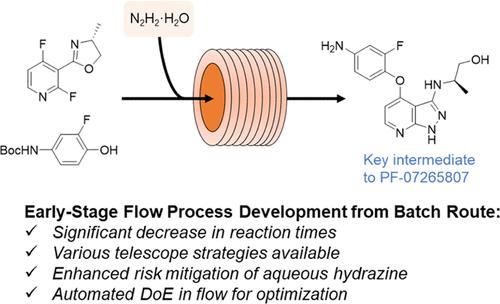AXL-MER 抑制剂肿瘤候选药物 PF-07265807 关键中间体的早期流式工艺开发
IF 3.1
3区 化学
Q2 CHEMISTRY, APPLIED
引用次数: 0
摘要
在研发和放大过程中,应用连续工艺可以带来某些优势,例如通过伸缩步骤和避免中间分离,可以加强危险化合物的风险缓解,减少生产周期时间和溶剂浪费。虽然伸缩并不是流式工艺所独有的,但只有在流式工艺中才能实现的工艺强化所带来的操作窗口是值得注意的,而且它们通常还具有获得批次工艺中无法实现的化学成分的额外优势。在这项工作中,我们重点介绍了如何将 AXL-MER 抑制剂候选肿瘤药物 PF-07265807 的早期批量路线转化为可行的连续流工艺。获得关键中间体的路线包括两个 SNAr 反应,后者利用水性肼实现分子内级联反应,然后进行 Boc 脱保护。通过寻找一种既能保持所有物种的溶解度又能导致有效反应的溶剂/碱体系,我们努力评估并证明了该工艺在流动过程中伸缩步骤的适用性。此外,还进行了其他研究,以将连续工艺中用作进料的肼水溶液浓度降至 5 wt %,从而增加了传统间歇工艺所不具备的各种安全优势。此外,还针对肼水溶液步骤进行了自动 D- 优化实验设计研究,以增加对工艺的了解,并在开发的早期阶段筛选效果。本文章由计算机程序翻译,如有差异,请以英文原文为准。

Early-Stage Flow Process Development of a Key Intermediate toward PF-07265807, an AXL-MER Inhibitor Oncology Candidate
The application of continuous processing can afford certain advantages during development and scale-up, such as enhanced risk mitigation of hazardous compounds and reducing both manufacturing cycle time and solvent waste through telescoping steps and avoiding intermediate isolations. While telescoping is not unique to flow, the operating windows enabled by the process intensification only possible in flow are notable, and they often possess the additional benefit of accessing chemistries not feasible in a batch. In this work, we highlight efforts to translate an early-stage batch route for the AXL-MER inhibitor oncology candidate PF-07265807 into a viable continuous flow process. The route to the key intermediate of interest features two SNAr reactions, the latter utilizing aqueous hydrazine to enable an intramolecular cascade reaction, followed by a Boc deprotection. Efforts were made to assess and demonstrate the suitability of the process for telescoping steps in flow by finding a solvent/base system that maintained the solubility of all species and led to efficacious reactions. Additional studies were performed to reduce the concentration of aqueous hydrazine solution used as a feed in the continuous process to 5 wt % hydrazine, adding to the various safety advantages not amenable to a traditional batch process. Furthermore, an automated D-optimal design of experiment study was carried out for the aqueous hydrazine step to increase process understanding and screen effects during this early stage of development.
求助全文
通过发布文献求助,成功后即可免费获取论文全文。
去求助
来源期刊
CiteScore
6.90
自引率
14.70%
发文量
251
审稿时长
2 months
期刊介绍:
The journal Organic Process Research & Development serves as a communication tool between industrial chemists and chemists working in universities and research institutes. As such, it reports original work from the broad field of industrial process chemistry but also presents academic results that are relevant, or potentially relevant, to industrial applications. Process chemistry is the science that enables the safe, environmentally benign and ultimately economical manufacturing of organic compounds that are required in larger amounts to help address the needs of society. Consequently, the Journal encompasses every aspect of organic chemistry, including all aspects of catalysis, synthetic methodology development and synthetic strategy exploration, but also includes aspects from analytical and solid-state chemistry and chemical engineering, such as work-up tools,process safety, or flow-chemistry. The goal of development and optimization of chemical reactions and processes is their transfer to a larger scale; original work describing such studies and the actual implementation on scale is highly relevant to the journal. However, studies on new developments from either industry, research institutes or academia that have not yet been demonstrated on scale, but where an industrial utility can be expected and where the study has addressed important prerequisites for a scale-up and has given confidence into the reliability and practicality of the chemistry, also serve the mission of OPR&D as a communication tool between the different contributors to the field.

 求助内容:
求助内容: 应助结果提醒方式:
应助结果提醒方式:


